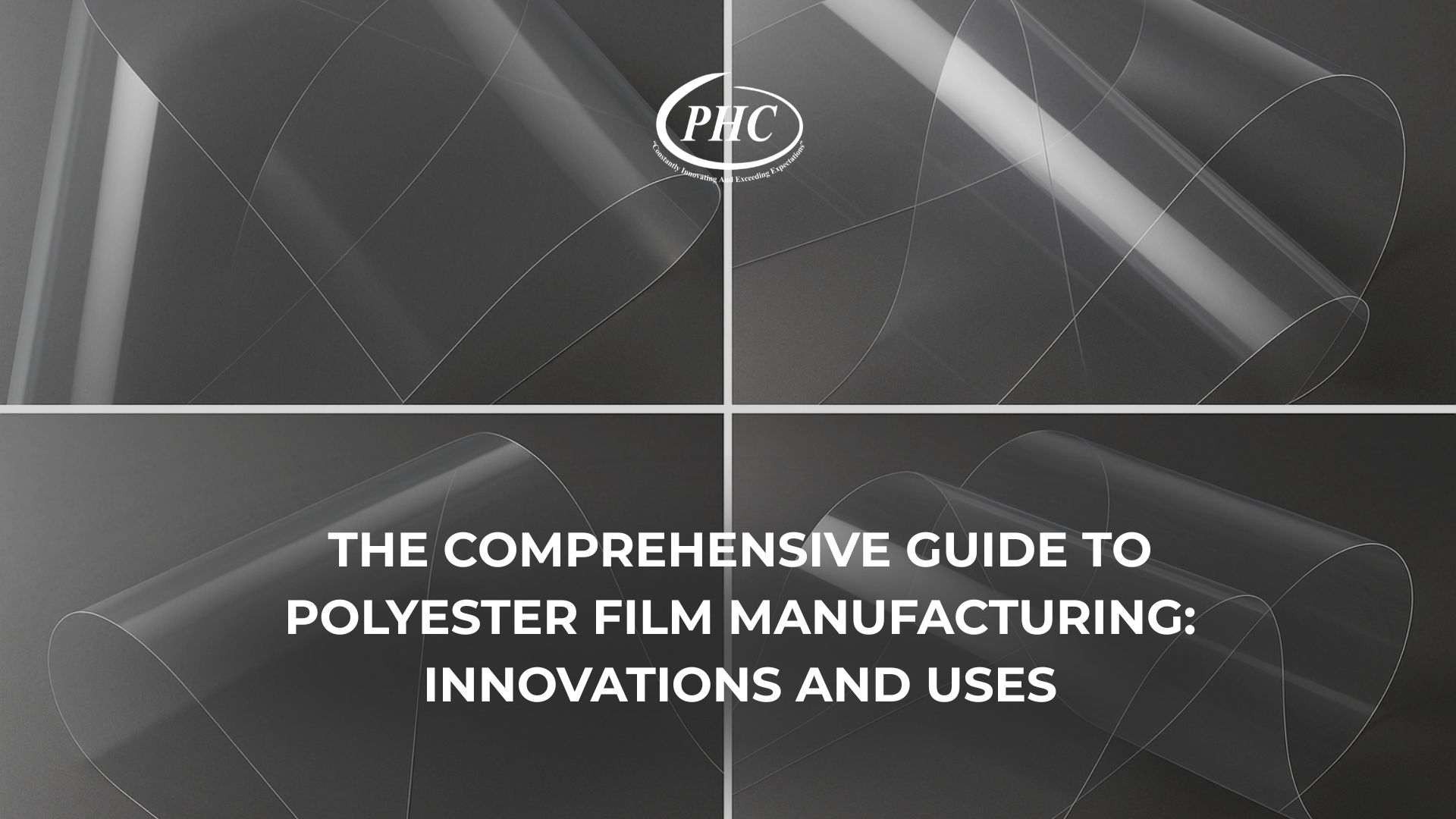Polyester films owe their remarkable properties to the underlying polymer chemistry of polyethylene terephthalate (PET) and the manufacturing processes that transform resin into thin, biaxially oriented sheets. Pilcher Hamilton Corporation (PHC) combines deep technical expertise with state‑of‑the‑art equipment to produce films that meet demanding mechanical, thermal and electrical requirements. This article dives into the science of PET polymerization, orientation and film properties, contrasting PET with other plastics and highlighting how PHC tailors film characteristics for diverse applications.
What Makes Polyester Films Essential in Modern Industries?
At the heart of PET is a repeating ester linkage between terephthalic acid and ethylene glycol. When polymerized, these monomers form long chains with aromatic rings that lend rigidity and strength. PET’s intrinsic mechanical robustness, chemical resistance and thermal stability set it apart from softer plastics like polyethylene (PE) and polypropylene (PP). As a result, PET is used for high tensile strength plastic film, electrical insulation film, packaging film, polyester plastic sheet, polyester and polyethylene composites, and many other products.
PET Polymer Chemistry and Polymerization
Polyethylene terephthalate is synthesized through either transesterification of dimethyl terephthalate with ethylene glycol or direct esterification of terephthalic acid with ethylene glycol. The process produces water or methanol as byproducts. Subsequent polycondensation increases molecular weight, forming long polymer chains. The repeating unit consists of aromatic benzene rings connected via ester linkages and ethylene glycol segments. This rigid backbone imparts stiffness and thermal resistance. Additives like catalysts, stabilizers and chain extenders tailor molecular weight distribution and processability.
After polymerization, PET is extruded into chips or pellets (often called polyester chips). These chips are dried to remove moisture and then melted and extruded into a thick film sheet. The sheet passes through stretching stages where it is oriented sequentially in the machine direction and transverse direction—a process known as biaxial orientation. Orientation aligns polymer chains, increasing tensile strength, modulus and barrier properties while reducing thickness. Finally, heat setting locks the oriented structure by annealing at high temperatures to relieve stresses and stabilize dimensions. The result is biaxially oriented PET (BOPET), commonly sold under trade names like Mylar®, Melinex® and Hostaphan®.
How Biaxial Orientation Enhances Properties
During biaxial orientation, the film is stretched about 3–4× in each direction. This alignment improves tensile strength from around 80 MPa in unoriented PET to 190–260 MPa in BOPET film. The modulus increases to 2–4 GPa, giving the film rigidity. Barrier properties improve because oriented chains leave fewer free volume pathways for gases. Heat setting crystallizes some segments, raising dimensional stability and thermal resistance—films can withstand up to 240–260 °F, with heat‑stabilized grades handling 300 °F. The process also imparts flatness and optical clarity, desirable for printing and lamination.
Comparing PET with Other Plastics
| Property | PET | Polypropylene (PP) | Polyethylene (PE) | Polycarbonate (PC) |
| Density (g/cm³) | 1.3–1.4 | 0.90 | 0.91–0.96 | 1.20 |
| Tensile strength (MPa) | 80 (unoriented), 190–260 (BOPET) | 30–40 | 20–30 | 70 |
| Heat resistance (°F) | 240–260 (standard), up to 300 heat‑stabilized | ~210 | 176–230 | 250 |
| Water absorption (%) | < 0.1 | Slight | Low | 0.12 |
| Dielectric strength (kV/mm) | 17 (bulk), 300 for 25 µm film | 20 | 20 | 16 |
| Chemical resistance | Excellent for acids and solvents; poor for alkalis | Excellent except oxidative acids | Excellent | Good, attacked by bases |
PET offers a unique blend of high strength, good heat resistance and excellent barrier properties, making it ideal for films. PP and PE are more flexible and lower density but provide inferior gas barriers. PC has comparable strength but is more expensive and prone to hydrolysis. Understanding these differences helps designers choose the right polymer for applications.
Core Properties of PET Films from Leading Manufacturers
As summarized earlier, BOPET films have tensile strength up to 260 MPa, modulus 2–4 GPa, dielectric strength 300 kV/mm (for 25 µm film) and low moisture absorption. These attributes, combined with high clarity and chemical resistance, enable PET to outperform many other plastics in demanding applications like high performance film, electrical insulation film, digital printing film, polymer film sheeting and high temperature plastic film.
Key Applications in Packaging, Electronics, and Beyond
· Packaging film – PET’s high tensile strength allows the production of thin, durable films for snack bags, coffee pouches and frozen food lidding. Biaxial orientation provides clarity and barrier performance; coatings can add metalized shine or PVDC barrier.
· Electrical insulation – The high dielectric strength of BOPET (300 kV/mm for thin films) makes it ideal for capacitors, motor insulation and flexible printed circuits. Die‑cut PET serves as separators in batteries and electronic devices.
· Graphics and imaging – Films like Melinex offer optical clarity, dimensional stability and chemical resistance, making them suitable for photos, printing, and labels.
· Industrial and composites – PET films reinforce composite structures in aerospace and construction. They serve as release liners for adhesives, membranes for filtration and substrates for sensors.
Converting Expertise: Tailoring Film Properties at PHC
Understanding polymer science is only part of the equation. PHC applies this knowledge through precise converting services. Slitting, sheeting, winding, die‑cutting and toll converting tailor film dimensions and shapes for specific equipment[4][5][6][7][8]. For example, printed electronics require narrow, tightly controlled widths; PHC’s slitting ensures consistent edge quality. Optical applications demand flawless surfaces; sheeting provides flatness and thickness uniformity. Die‑cutting shapes PET into gaskets or optical windows, preserving film integrity. Toll converting allows clients to utilize PHC’s equipment for specialized processing, reducing capital investment and waste[9].
Emerging Trends: Polymer Engineering and Future Films
· Nanocomposites – Incorporating nanoparticles such as clay, silica or graphene into PET can dramatically improve barrier properties, thermal conductivity or electrical conductivity.
· Copolyesters – Modifying the PET chain with comonomers (e.g., isophthalic acid, cyclohexane dimethanol) creates copolyesters with altered crystallinity, heat sealability and clarity. PETG and PCTA are examples.
· Biodegradable blends – Research is exploring blending PET with biodegradable polymers to improve end‑of‑life options. However, compatibility and property retention remain challenges.
· Functionalized surfaces – Plasma treatments, UV grafting and chemical coatings add functionality (hydrophilicity, antimicrobial properties, or conductive paths) without bulk additives.
Why Choose a USA‑Based Polyester Film Manufacturer Near Me?
Polymer science is complex, and converting high‑performance film requires technical know‑how. Partnering with a USA polyester film manufacturer like PHC ensures close collaboration between engineers, quality teams and customers. Domestic production allows rigorous quality control, quick turnaround (orders fulfilled within 24–48 hours[10]), and adherence to environmental and safety regulations. For projects requiring high technical support—like developing a new polymer film with specific dielectric or tensile properties—local expertise is invaluable.
From monomer synthesis through biaxial orientation and heat setting, the chemistry of polyester films underpins their performance. Pilcher Hamilton Corporation harnesses this polymer science to deliver films that meet stringent mechanical, thermal and electrical requirements. Coupled with precision converting services and a strategic location in Greer, South Carolina, PHC stands as the premier polyester film manufacturer for clients seeking advanced materials and technical collaboration.
To discuss how PET chemistry can be tailored for your application, contact PHC’s technical team via their contact page. Explore technical datasheets and film specs to learn more about available grades. For solutions that require complex shapes or special surface treatments, consider PHC’s die‑cutting and coating services.
This infographic illustrates the PET polymer structure and the key steps of film manufacturing: extrusion, biaxial orientation and heat setting. It symbolizes the scientific foundation behind Pilcher Hamilton’s high‑performance polyester films.

